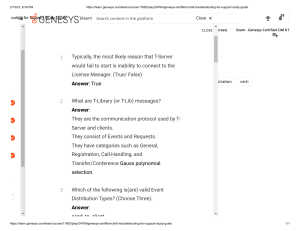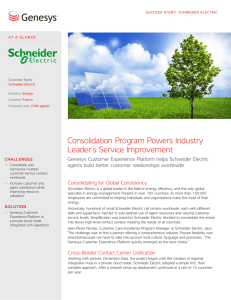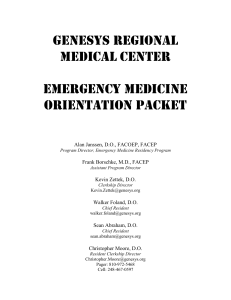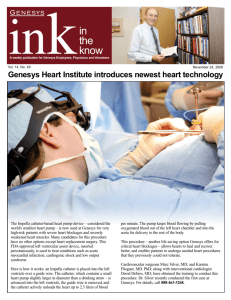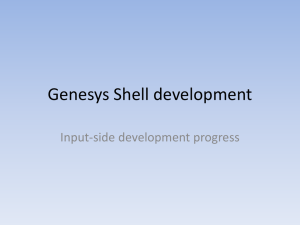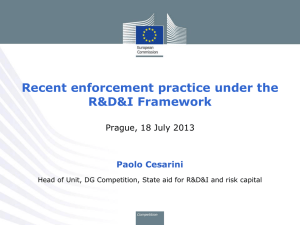Week 8. Steady Flow Engineering Devices
advertisement
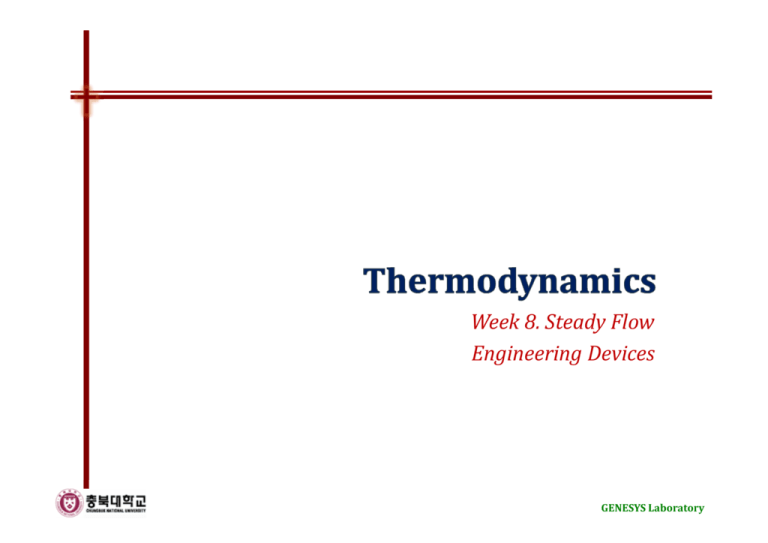
Week 8. Steady Flow Engineering Devices GENESYS Laboratory Objectives 1. 2. Solve energy balance problems for common steady-flow devices such as nozzles, compressors, turbines, throttling valves, mixers, heaters, and heat exchangers Apply the energy balance to general unsteady-flow processes with particular emphasis on the uniform-flow process as the model for commonly encountered charging and discharging processes GENESYS Laboratory Some Steady-Flow Engineering Devices • The components of a steam plant (Turbines, compressors, heat exchanger, and pumps) can be conveniently analyzed as steady-flow devices. GENESYS Laboratory Nozzles and Diffusers • Nozzle: a device that increases the velocity of a fluid at the expense of pressure • Diffuser : a device that increases the pressure of a fluid by slowing it down 2 2 V − V 1 Qɺ − Wɺ = mɺ h2 − h1 + 2 + g ( z2 − z1 ) 2 Assumptions Qɺ ≈ 0 (the fluid has high velocity) Wɺ = 0 ∆pe ≅ 0 V22 − V12 h1 − h2 = 2 Subsonic flows GENESYS Laboratory Ex1) Deceleration of Air in a Diffuser GENESYS Laboratory Ex2) Acceleration of Steam in a Nozzle GENESYS Laboratory Turbines and Compressors • Turbine: a device that drives the electric generator • Compressor: a device that increases the pressure of a fluid 2 2 V V − 2 1 Qɺ − Wɺ = mɺ h2 − h1 + + g ( z2 − z1 ) 2 Assumptions Qɺ ≈ 0 (well insulated) ∆pe ≅ 0 ∆ke ≅ 0 ← ∆ke⟨⟨∆h Wɺ = mɺ ( h1 − h2 ) GENESYS Laboratory Compressor During the same t GENESYS Laboratory Ex3) Compressing Air by a Compressor GENESYS Laboratory Ex4) Power Generation by a Steam Turbine GENESYS Laboratory Throttling Valves • Throttling valve: a device that cause large pressure drops in the fluid 2 2 V − V 2 1 ɺ ɺ + g ( z2 − z1 ) Q − W = mɺ h2 − h1 + 2 Assumptions Qɺ ≈ 0 (well insulated) Wɺ ≈ 0 ∆pe ≅ 0 ∆ke ≅ 0 ← ∆ke⟨⟨∆h h2 ≅ h1 ← isenthalpic device or constant enthalpy device ⇒ u1 + Pv 1 1 = u2 + P2 v2 GENESYS Laboratory Ex5) Expansion of Refrigerant-134a in a Refrigerator GENESYS Laboratory Mixing Chambers • Mixing chamber: a section where the mixing process takes place 2 2 V − V 2 1 ɺ ɺ Q − W = mɺ h2 − h1 + + g ( z2 − z1 ) 2 Assumptions Qɺ ≈ 0 (well insulated) Wɺ = 0 ∆pe ≅ 0 ∆ke ≅ 0 mɺ ( h1 − h2 ) = 0 GENESYS Laboratory Ex6) Mixing of Hot and Cold Waters in a Shower 60˚C 150 kPa 10˚C 45˚C GENESYS Laboratory Heat Exchangers • Heat exchanger: a device where two moving fluid streams exchange heat without mixing 2 2 − V V 2 1 ɺ ɺ Q − W = mɺ h2 − h1 + + g ( z2 − z1 ) 2 Assumptions Qɺ → depending on the control volume Wɺ = 0 ∆pe ≅ 0 ∆ke ≅ 0 mɺ ( h1 − h2 ) = 0 mɺ ( h − h ) = Qɺ 2 1 GENESYS Laboratory Ex7) Cooling of Refrigerant-134a by Water GENESYS Laboratory Pipe and Duct Flow 2 2 V − V 2 1 Qɺ − Wɺ = mɺ h2 − h1 + + g ( z2 − z1 ) 2 Assumptions Qɺ → depending on the control volume Wɺ → depending on the control volume ∆pe ≅ 0 ∆ke ≅ 0 Qɺ cv − Wɺcv = mɺ ( h2 − h1 ) at incompressible substance ∆h = h2 − h1 = ( u 2 −u1 ) + v ( P2 − P1 ) = c(T2 − T1 ) + v ( P2 − P1 ) GENESYS Laboratory Ex8) Electric Heating of Air in a House GENESYS Laboratory Energy Analysis of Unsteady-Flow Processes • Unsteady-flow : processes involving changes within the control volume with time • The shape and size of a control volume may change during an unsteady-flow process • Uniform flow process: the fluid flow at any inlet or exit is uniform and steady, and thus the fluid properties do not change with time or position over the cross section of an inlet or exit. If they do, they are averaged and treated as constants for the entire process. GENESYS Laboratory Energy Analysis of Unsteady-Flow Processes II • Energy balance for a uniform-flow system + + θ − + + θ Q W m Q W m ∑ ∑ in out = ( m2 e2 − m1e1 )system in out in out where, θ = h + ke + pe e = u + ke + pe If ∆KE ≅ 0, ∆PE ≅ 0 Q − W = ∑ mh −∑ mh + ( m2u2 − m1u1 )system out in Q = Qnet,in = Qin − Qout W = Wnet,out = Wout − Win • Although both the steady-flow and uniform-flow processes are somewhat idealized, many actual processes can be approximated reasonably well by one of these with satisfactory results GENESYS Laboratory Summary An universal form of Energy balance equation desystem ein − eout = =0 dt mass balance mi − me = (m2 − m1 )CV for a general steady-flow system Qin + Win + ∑ mθ − Qout + Wout + ∑ mθ = 0 in out for a general unsteady-flow system Q + W + m θ − Q + W + m θ ∑ ∑ in out = ( m2 e2 − m1e1 )system in out in out where, θ = h + ke + pe e = u + ke + pe GENESYS Laboratory Ex9) Charging of a Rigid Tank by Steam GENESYS Laboratory Ex10) Cooking with a Pressure Cooker GENESYS Laboratory
